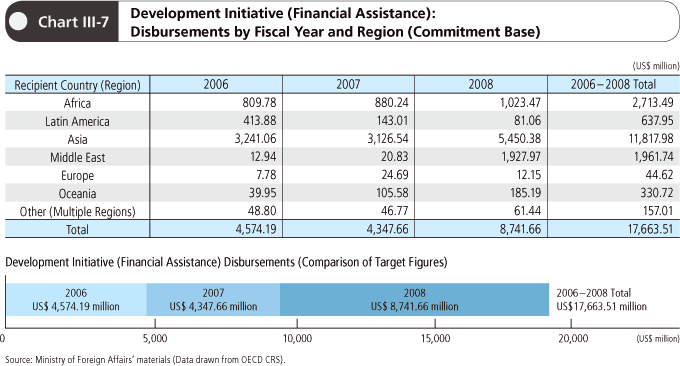Japan's Official Development Assistance White Paper 2010
(3) Cooperation between Trade, Investment, and Other Official Flows (OOF)
It is key that the private sector play a leading role for sustainable growth in developing countries, and therefore it is important to promote industry and vitalize private sector activities such as trade and investment. Yet in developing countries beset by numerous challenges it can sometimes be difficult to set in place an environment for attracting private investment, and so support from the international community is essential.
<Japan’s Efforts>
Japan utilizes ODA and Other Official Flows (OOF) to support efforts like promoting small and medium-scale enterprises in developing countries, transferring industrial technology, and economic policies. Moreover, it also supports the improvement of trade and investment environments and economic infrastructure in order to improve the export capabilities and competitiveness of developing countries. The WTO Doha Round Negotiations (The Doha Development Agenda) which started in 2001 emphasizes the promotion of development through participation in the multilateral trading system by developing countries. Japan has contributed to the trust fund set up within the WTO in aiming to improve the capacity of developing countries to participate in negotiations and for their implementation of the WTO agreements.
Regarding access to Japanese markets, Japan carries out the Generalized System of Preferences (GSP), which adopts lower tariff rates than general rates for exports of products from developing countries. Duty-Free and Quota-Free measures (Note 18) are also taken for Least Developed Countries (LDCs). Japan also actively promotes Economic Partnership Agreements (EPAs), and supports economic growth in developing countries through the liberalization of trade and investment.
In recent years, discussions have intensified over Aid for Trade (AfT) at various international fora, including the WTO and Organisation for Economic Co-operation and Development (OECD), as a means of further promoting support by developed countries, including Japan. On the occasion of the WTO Ministerial Conference in Hong Kong held in December 2005, Japan announced its unique contribution measure called the Development Initiative. Under one of its pillars, Japan will provide assistance totaling US$10 billion for trade-related projects, including technical cooperation projects for the dispatch of experts and acceptance of trainees totaling 10,000 people over a three-year period from 2006 to 2008.
Furthermore, based on the achievement of the Development Initiative, Japan announced the new Development Initiative for Trade 2009 at the WTO’s Second Global Review Meeting on Aid for Trade in July 2009. Under one of its pillars, Japan will provide assistance totaling approximately US$12 billion for trade-related projects, including technical cooperation projects for the dispatch of experts and acceptance of trainees totaling 40,000 people over a three-year period from 2009 to 2011. The initiative has garnered high praise from numerous countries, and is making steady progress. In terms of specific initiatives, Japan provides funds for the development of transport networks vital to trade, including ports, roads, and bridges, as well as for projects to construct power plants and power grids, among others. It also provides technical cooperation in trade-related areas, including education of customs officials (Note 19), while also offering support, which relates to the One Village, One Product Campaign. In addition, Japan supports developing countries to facilitate private sector investment by finding common challenges among developing countries and recommending several measures to promote investment.
Notes:
(18) The goods covered by the Duty-Free and Quota-Free measures for LDCs are expanding. The goods that can be imported duty-free and quota-free has increased to about 98% in terms of number and more than 99% in terms of trade value (as of October 2010).
(19) This initiative supports increasing the export of developing country products by uncovering intriguing products, such as handicrafts, textiles, and toys that reflect the rich ethnic character of developing countries in places like Asia and Africa, and making more people aware of them.


